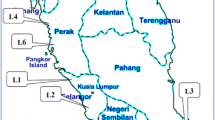Abstract
The Guarapiranga Reservoir is a very important aquatic system due to the fact that it is one of the main water reservoirs for South America’s largest city, São Paulo, Brazil. Guarapiranga basin is located within the Metropolitan Region of São Paulo and the reservoir itself is located in the Northern part of the basin occupying approximately 26 km2. This reservoir is characterized by environmental impacts from urban invasion, industrial and sewage wastes, all of which seriously affect its water quality and, consequently, the sediment quality. Two collection campaigns were undertaken: April 2009 and June 2010. The samples were analyzed by instrumental neutron activation analysis (INAA) in order to determine the following elements: major (Fe, K and Na), trace (As, Ba, Br, Co, Cr, Cs, Hf, Rb, Sb, Sc, Ta, Tb, Th, U and Zn) and rare earths (Ce, Eu, La, Lu, Nd, Sm, Tb and Yb). The organic matter and granulometric distribution were also evaluated and multivariate analysis was applied to the results. The study of elemental ratios indicated that the amount of elements present in the Guarapiranga Reservoir is mainly of detrital origin.



Similar content being viewed by others
References
Campagnoli F. (2006) Aplicação do assoreamento na definição de Geoindicadores Ambientais em áreas urbanas: exemplo na Bacia do Alto Tietê. 179 p. PhD Thesis, Escola Politécnica da USP, São Paulo, Brazil
SABESP—Companhia de Saneamento Básico do Estado de São Paulo, São Paulo, Brazil. http://site.sabesp.com.br. Accessed January 2011
DAEE— Departamento de Águas e Energia Elétrica, São Paulo, Brazil: http://www.daee.sp.gov.br (accessed January 2011)
ISA, Instituto Socioambiental, De olho nos mananciais, São Paulo, Brazil. http://www.mananciais.org.br. Accessed January 2011
Mateus R S. (2006) Modelo Hidrológico da Bacia Hidrográfica da Represa Guarapiranga, São Paulo,154 p. Master of Science, Faculdade de Filosofia, Letras e Ciências Humanas da USP, São Paulo, Brazil
ISA, Instituto Socioambiental, Seminário Guarapiranga (2006): Proposição de ações prioritárias para garantir água de boa qualidade para abastecimento público, São Paulo, Brazil. http://www.mananciais.org.br. Acessed January 2011
Quináglia G A (2006). Caracterização dos Níveis Basais de Concentração de Metais nos Sedimentos do Sistema Estuarino da Baixada Santista, 239 p. PhD Thesis, Instituto de Química da USP, São Paulo, Brasil
Bostelmann E.(2006) Avaliação da concentração de metais em amostras de sedimento do Reservatório Billings, Braço Rio Grande, São Paulo. 116 p. Master of Science, Instituto de Pesquisas Energéticas Nucleares, São Paulo, Brasil.
IAEA—INTERNATIONAL ATOMIC ENERGY AGENCY (2003) Collection and preparation of bottom sediment samples for analysis of radionuclides and trace elements, IAEA-TECDOC-1360
Camargo OA, Moniz AC, Jorge JA, Valadares JMAS (1986) Métodos de análise química e física de solos do IAC, Boletim Técnico 106, 94 p, Instituto Agronômico de Campinas—IAC, Campinas, Brasil
Larizzatti FE, Favaro DIT, Moreira SRD, Mazzilli BP, Piovano EL (2001) J Radioanal Nuclear Chem 249(1):263–268
Bode P (1996) Instrumental and organizational aspects of a neutron activation analysis laboratory. Interfaculty Reactor Institut, Delft, p 147
Condie KC (1993) Chem Geol 104:1–37
Figueiredo AMG, Sígolo JB, Enzweiler J, Camargo SP, Milian FM. (2009) Anais do X Congresso Brasileiro de Geoquímica, Ouro Preto, Minas Gerais, p.10
Gromet LP, Dymec RF, Haskin LA, Korotev RL (1984) Geochim Cosmochim Acta 48:2469–2482
Ghrefat H, Yusuf N (2006) Chemosphere 65:2114–2121
Külahci F, Şen Z (2008) Appl Radiat Isot 66:236–246
Vervoort JD, Patchett PJ, Blichert-toft J, Albarède F (1999) Earth Planet Sci Lett 168:79–99
Di Leonardo R, Bellanca A, Neri R, Tranchida G, Mazzola S (2009) Chemosphere 77:778–784
Frei R, Frei KM (2002) Earth Planet Sci Lett 203:691–708
Acknowledgments
The authors thank to Setor de Amostragem em Ambientes Aquáticos e Ensaios Granulométricos of CETESB (Companhia Ambiental do Estado de São Paulo) for sample collection and CNEN (Comissão Nacional de Energia Nuclear) for financial support.
Author information
Authors and Affiliations
Corresponding authors
Rights and permissions
About this article
Cite this article
Guimarães, G.M., Zahn, G.S., Franklin, R.L. et al. Neutron activation analysis applied in sediment samples from the Guarapiranga Reservoir for metals and trace elements assessment. J Radioanal Nucl Chem 291, 155–161 (2012). https://doi.org/10.1007/s10967-011-1225-5
Received:
Published:
Issue Date:
DOI: https://doi.org/10.1007/s10967-011-1225-5




